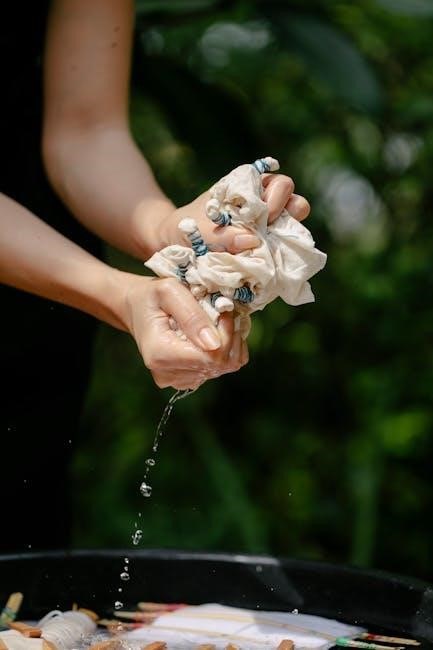
Definition of Tie and Dye
Tie and dye is a resist dyeing technique used to create unique patterns on fabric‚ involving folding‚ twisting‚ or pleating the fabric to resist the dye. This technique has been used in various cultures throughout history‚ with different methods and materials employed to achieve distinct effects. The definition of tie and dye encompasses a range of techniques‚ including binding‚ stitching‚ and folding‚ to create resistance areas on the fabric. By understanding the definition of tie and dye‚ individuals can explore the various methods and materials used in this ancient craft. With the help of online resources and PDF guides‚ beginners can learn about the different techniques and start creating their own tie and dye projects. The definition of tie and dye serves as a foundation for exploring the various aspects of this craft. Tie and dye techniques can be used to create a wide range of designs.
History of Tie and Dye
The history of tie and dye dates back thousands of years‚ with evidence of its use in ancient cultures such as Africa‚ Asia‚ and South America. This technique has been used to create unique and intricate designs on fabric‚ with different cultures developing their own methods and traditions. The history of tie and dye is a rich and diverse one‚ with various techniques and materials being used to achieve distinct effects. From the intricate patterns of African adire to the vibrant colors of Indian bandhani‚ tie and dye has played a significant role in the textile traditions of many cultures. With the passage of time‚ tie and dye has evolved and spread to different parts of the world‚ with new techniques and materials being introduced. The history of tie and dye is a testament to the creativity and ingenuity of human beings. Tie and dye has a long history.
Tie and Dye Patterns and Folding Techniques
Various patterns and folding techniques are used to create unique tie and dye designs on fabrics using different methods and materials available online.
Tie and Dye Patterns
Tie and dye patterns involve creating unique designs on fabrics using resist dyeing techniques‚ with various methods available to achieve different effects.
The patterns can range from simple to complex‚ depending on the folding and binding techniques used.
Online resources and PDF guides provide instructions and inspiration for creating different tie and dye patterns‚ including spiral‚ stripe‚ and polka dot designs;
These resources often include step-by-step tutorials and photos to help beginners learn the techniques.
With practice and experimentation‚ crafters can create their own unique tie and dye patterns and designs‚ using a variety of materials and methods.
The possibilities for tie and dye patterns are endless‚ making it a fun and creative activity for crafters of all skill levels.
Tie and dye patterns can be used to create a wide range of products‚ from clothing and accessories to home decor items.
Folding Techniques
Folding techniques are a crucial part of tie and dye‚ as they determine the resist areas and resulting patterns.
Various folding methods can be used‚ including accordion‚ spiral‚ and knot folding.
Each technique creates a unique resist effect‚ allowing for a wide range of patterns and designs.
Online resources and PDF guides provide detailed instructions and diagrams for different folding techniques.
These guides often include photos and step-by-step tutorials to help crafters master the folding methods.
With practice‚ crafters can experiment with different folding techniques to achieve their desired patterns.
Folding techniques can be combined with various binding and dyeing methods to create complex and interesting designs.
The folding technique used can greatly impact the final result‚ making it an essential part of the tie and dye process.
Proper folding techniques are necessary to achieve the desired resist effect and pattern.

Types of Tie and Dye
Various types of tie and dye exist‚ including traditional methods and modern techniques freely available online.
Bandhani Tie and Dye
Bandhani tie and dye is a traditional Indian technique that involves tying small sections of fabric to create resistance areas‚ resulting in unique patterns and designs. This method has been used for centuries to create intricate and beautiful textiles. The process of bandhani tie and dye is labor-intensive and requires great skill and patience. The fabric is first folded and tied into small knots‚ and then dyed in a variety of colors. The tied areas resist the dye‚ creating a resist effect that is characteristic of bandhani tie and dye. The resulting fabric is then washed and ironed to reveal the intricate patterns and designs. Bandhani tie and dye is a popular technique among textile artists and designers‚ and is often used to create stunning garments and home furnishings. The technique is also used to create intricate patterns on scarves and other accessories.
Shibori Tie and Dye
Shibori tie and dye is a Japanese technique that involves folding‚ twisting‚ or pleating fabric to create resistance areas‚ resulting in unique patterns and designs. This method is similar to bandhani‚ but uses a variety of folding and binding techniques to achieve different effects. Shibori tie and dye can be used to create a wide range of patterns‚ from simple to complex‚ and is often used to create stunning textiles and garments. The technique is highly versatile and can be used with a variety of fabrics and dyes. Shibori tie and dye is a popular technique among textile artists and designers‚ and is often used to create unique and intricate patterns on fabric. The resulting textiles are highly prized for their beauty and uniqueness‚ and are often used to create high-end garments and home furnishings. Shibori tie and dye is a labor-intensive process.
Tie and Dye with Natural Dyes
Natural dyes are used with tie and dye techniques to create unique textiles and fabrics with earthy tones and colors very easily and effectively always.
Using Natural Dyes
Using natural dyes in tie and dye techniques is a popular method for creating unique and sustainable textiles. This method involves using dyes derived from plants‚ such as indigo‚ turmeric‚ and pomegranate‚ to create a range of colors and shades. The process of using natural dyes requires some patience and experimentation‚ as the colors can be unpredictable and may vary depending on the type of fabric and dye used. However‚ the end result is often a beautiful and distinctive textile with a natural‚ earthy quality. Many online resources and PDF guides are available to help beginners get started with using natural dyes in tie and dye techniques‚ including recipes for common natural dyes and tips for achieving specific colors and effects. Natural dyes can be used to create a wide range of colors and patterns.
Types of Natural Dyes
There are many types of natural dyes that can be used in tie and dye techniques‚ including plant-based dyes‚ such as indigo‚ madder‚ and pomegranate. These dyes can be used to create a range of colors‚ from blues and reds to yellows and oranges. Other types of natural dyes include insect-based dyes‚ such as cochineal‚ and mineral-based dyes‚ such as iron and copper. Each type of natural dye has its own unique characteristics and requirements‚ and some may be more suitable for certain types of fabric or tie and dye techniques. Online resources and PDF guides can provide more information on the different types of natural dyes available and how to use them. Natural dyes can be mixed and combined to create a wide range of colors and shades‚ making them a versatile option for tie and dye artists. Various resources are available online.

Resources for Tie and Dye
Online resources and PDF guides provide information and instructions on tie and dye techniques and methods for beginners and experts alike to learn freely always.
PDF Instructions
PDF instructions are available for various tie and dye techniques‚ providing step-by-step guides for creating unique designs and patterns on fabric. These instructions can be downloaded from online resources and used as a reference for beginners and experts alike. The PDF guides often include photos and written directions‚ making it easy to follow along and achieve the desired results. Many websites offer free PDF downloads‚ while others may require a subscription or purchase. Additionally‚ some PDF instructions may focus on specific techniques‚ such as shibori or bandhani‚ while others may provide a general overview of tie and dye methods. By using PDF instructions‚ individuals can learn new skills and techniques‚ and create their own unique tie and dye designs. Overall‚ PDF instructions are a valuable resource for anyone interested in tie and dye. They are easy to access and use.
Online Resources
Online resources are plentiful for learning tie and dye techniques‚ with many websites offering tutorials‚ videos‚ and downloadable PDF guides. These resources can be accessed from anywhere with an internet connection‚ making it easy to learn and practice tie and dye at home. Some online resources also offer communities and forums where individuals can share their work‚ ask questions‚ and get feedback from others. Many websites specialize in specific techniques‚ such as shibori or natural dyeing‚ while others provide a broad overview of tie and dye methods. By utilizing online resources‚ individuals can learn new skills‚ stay up-to-date on the latest trends‚ and connect with others who share their interest in tie and dye. Online resources are a great way to get started with tie and dye‚ and can be a valuable tool for both beginners and experienced practitioners. They are easily accessible.




